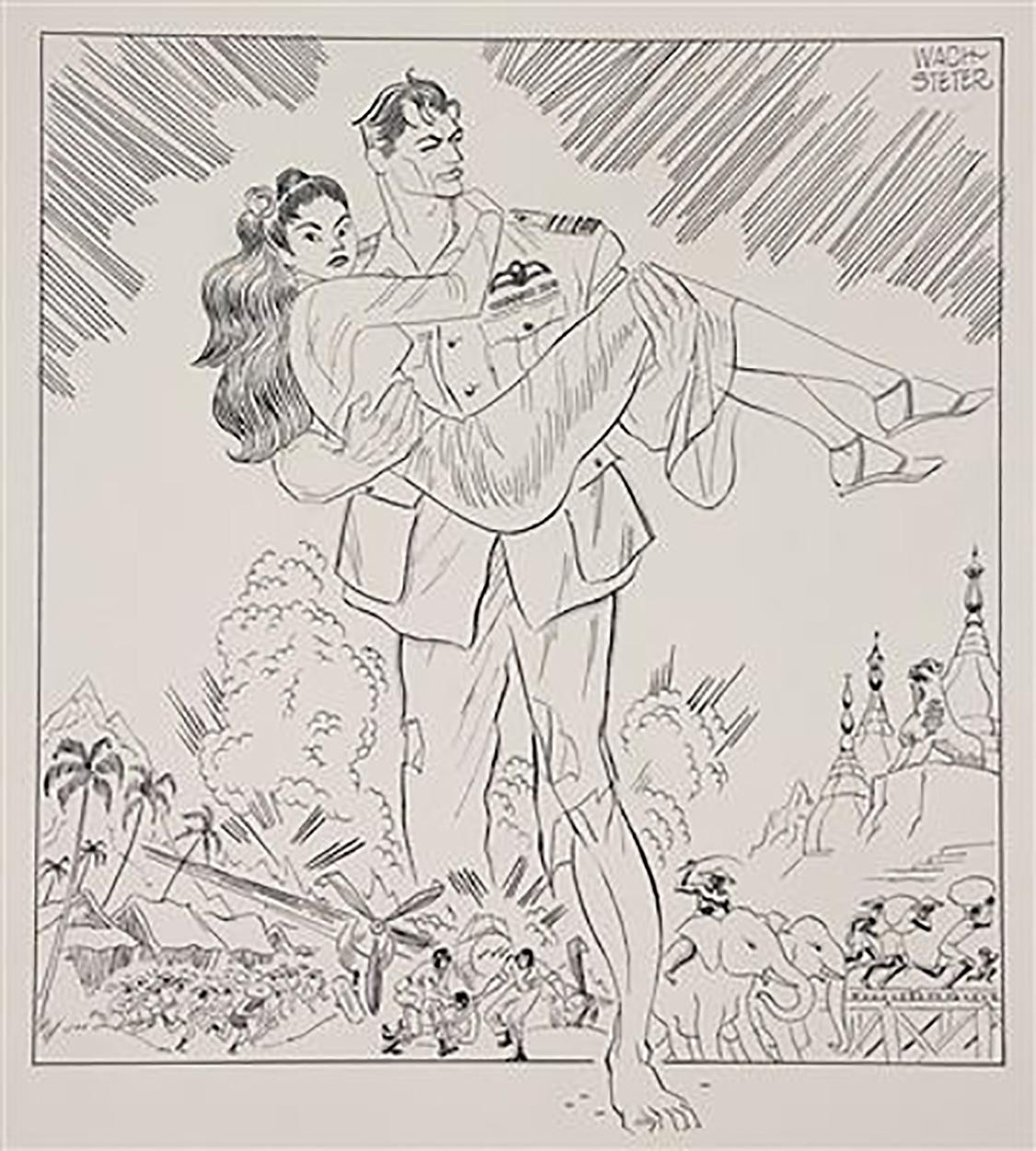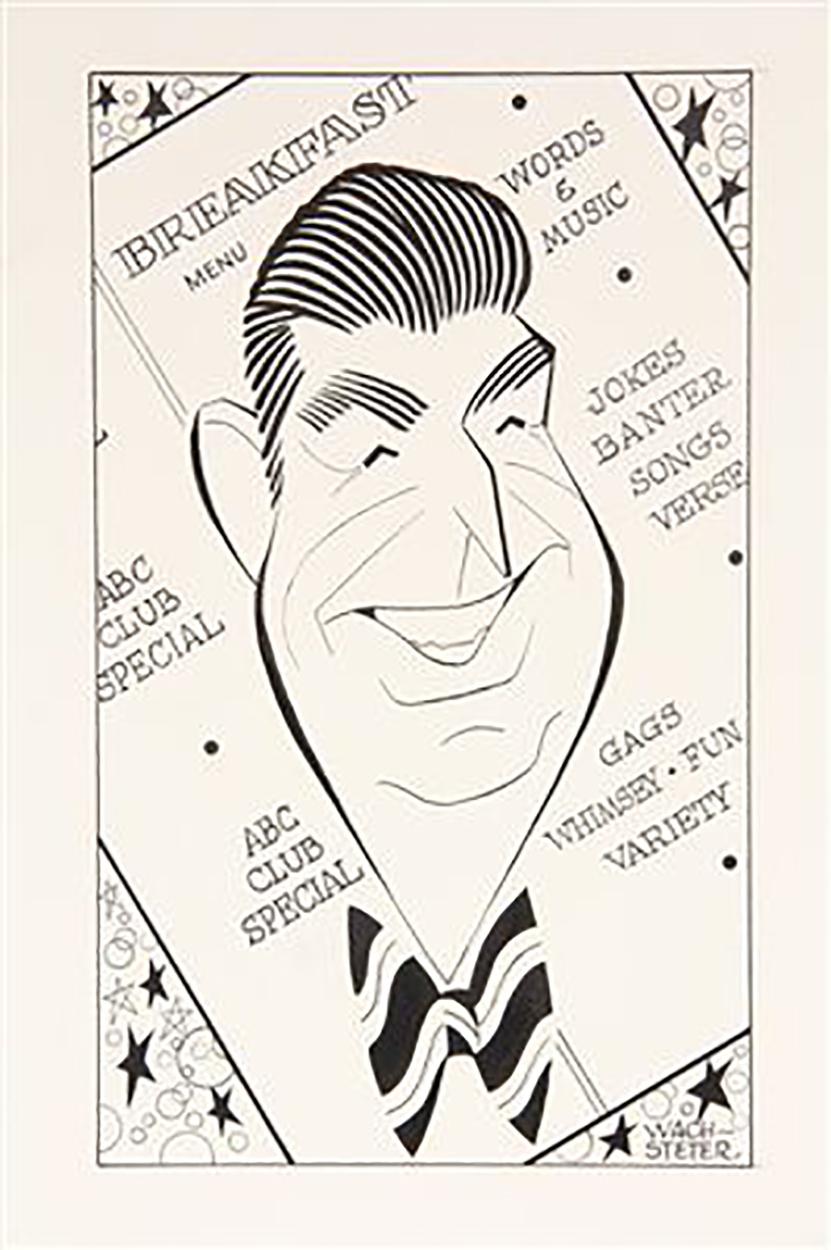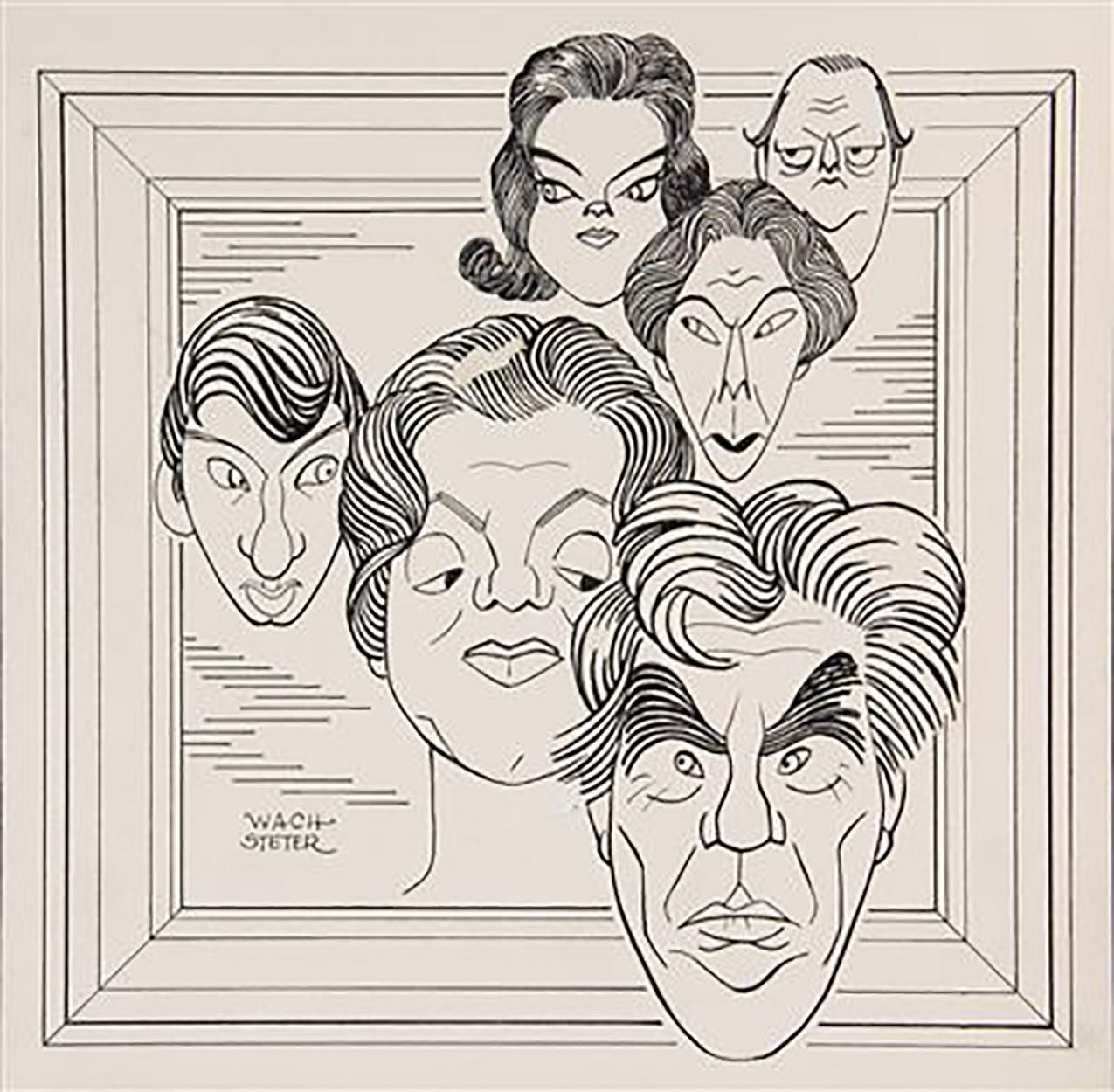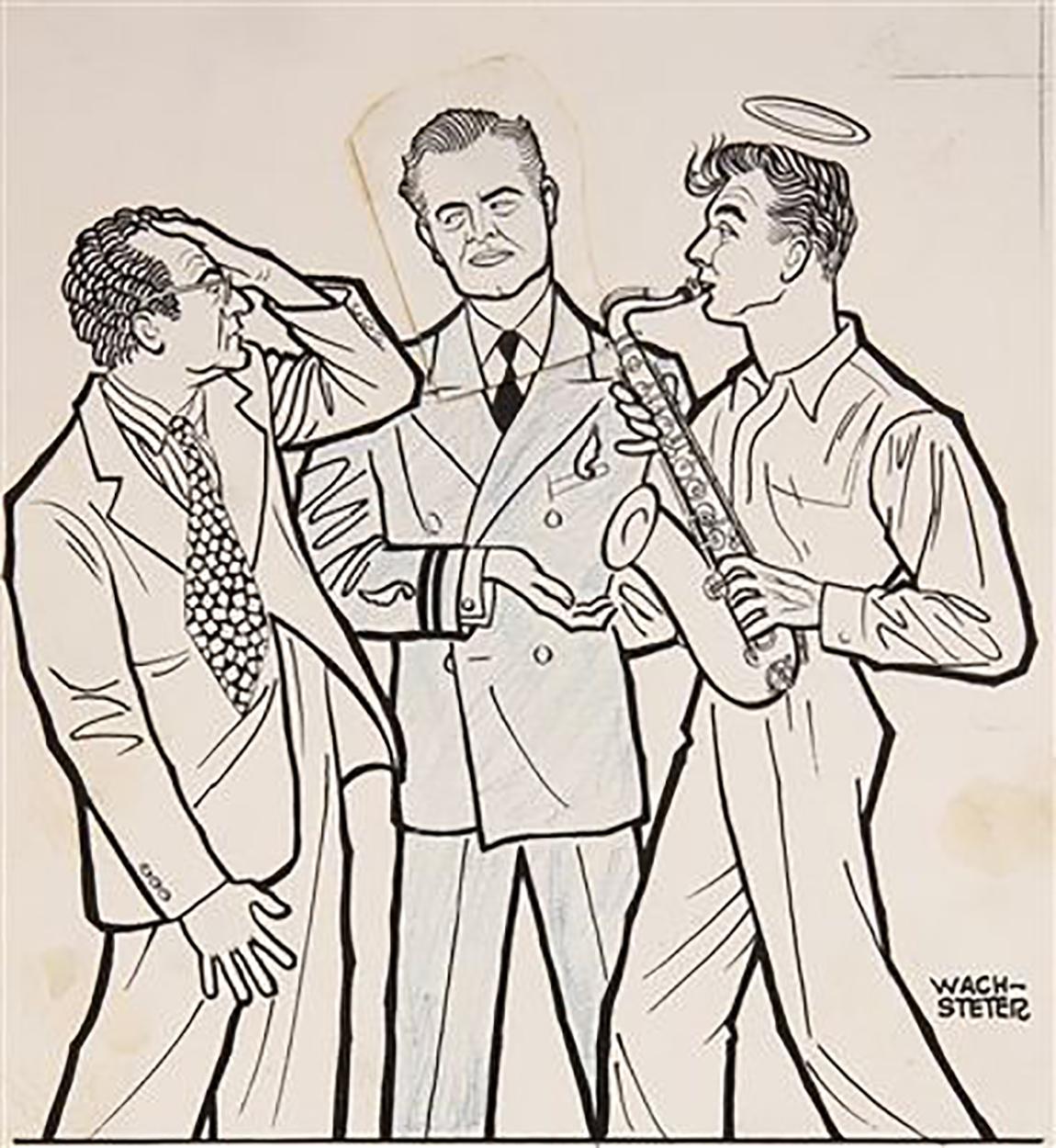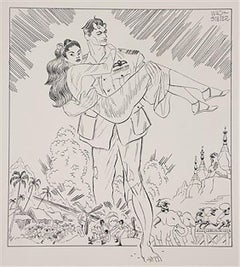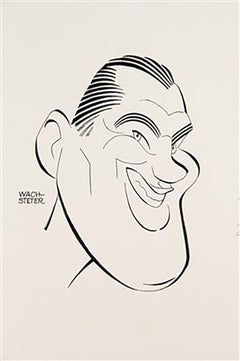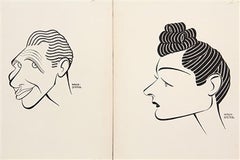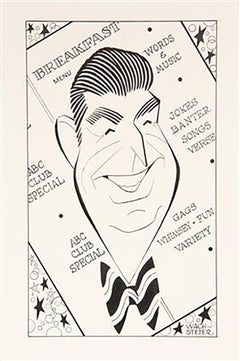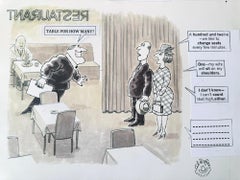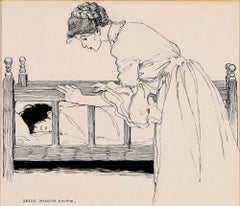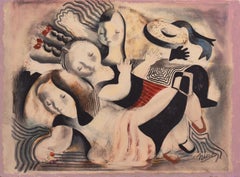Items Similar to John Lund as Yank in "The Hasty Heart"
Want more images or videos?
Request additional images or videos from the seller
1 of 2
George WachsteterJohn Lund as Yank in "The Hasty Heart"1945
1945
About the Item
Medium: Pen and Ink on Illustration Board
Signature: Signed Lower Left
Caricature by George Wachsteter (1911-2004) of John Lund as Yank in John Patrick`s 1945 Broadway wartime drama `The Hasty Heart` at the Hudson Theatre. Starring Richard Basehart, this insightful character study set in a British hospital on the Burma front marked the Broadway debut of Robert Earl Jones (under the name Earl Jones), the father of James Earl Jones. Directed by Bretaigne Windust, designed by Raymond Sovey, the show ran 1/3/45 - 6/30/45 for 204 performances, featured Earl Jones. This drawing appeared in the New York Journal-American during the run, includes clipping.
This illustration is on 14.50" x 10.00" illustration board, with blue indicating halftone. The image itself measures to 9.50" x 8.50."
- Creator:George Wachsteter (1911 - 2004)
- Creation Year:1945
- Dimensions:Height: 9.5 in (24.13 cm)Width: 8.5 in (21.59 cm)
- Medium:
- Period:
- Condition:Minor soiling, editor's notes in margins.
- Gallery Location:Fort Washington, PA
- Reference Number:Seller: 24221stDibs: LU38436192062
About the Seller
5.0
Recognized Seller
These prestigious sellers are industry leaders and represent the highest echelon for item quality and design.
Gold Seller
Premium sellers maintaining a 4.3+ rating and 24-hour response times
Established in 1995
1stDibs seller since 2016
122 sales on 1stDibs
Typical response time: 4 hours
- ShippingRetrieving quote...Shipping from: Fort Washington, PA
- Return Policy
Authenticity Guarantee
In the unlikely event there’s an issue with an item’s authenticity, contact us within 1 year for a full refund. DetailsMoney-Back Guarantee
If your item is not as described, is damaged in transit, or does not arrive, contact us within 7 days for a full refund. Details24-Hour Cancellation
You have a 24-hour grace period in which to reconsider your purchase, with no questions asked.Vetted Professional Sellers
Our world-class sellers must adhere to strict standards for service and quality, maintaining the integrity of our listings.Price-Match Guarantee
If you find that a seller listed the same item for a lower price elsewhere, we’ll match it.Trusted Global Delivery
Our best-in-class carrier network provides specialized shipping options worldwide, including custom delivery.More From This Seller
View All"The Purple Plain"
By George Wachsteter
Located in Fort Washington, PA
Medium: Pen and Ink on Illustration Board
Signature: Signed Upper Right
Caricature by George Wachsteter (1911-2004) for the 1954 United Artists WWII Action Movie, `The Purple Plain`...
Category
1950s Figurative Drawings and Watercolors
Materials
Ink, Illustration Board, Pen
Jay Hanna "Dizzy" Dean
By George Wachsteter
Located in Fort Washington, PA
Medium: Pen and Ink on Illustration Board
Signature: Signed Center Left
This illustration is on 15.00" x 11.00" illustration board, the drawing itself measuring to 8.00" x 6.00."
Ca...
Category
1950s Figurative Drawings and Watercolors
Materials
Ink, Illustration Board, Pen
Ralph Bellamy & Ruth Hussey (2)
By George Wachsteter
Located in Fort Washington, PA
Medium: Pen and Ink on Illustration Board
Signature: Signed Center Right and Lower Right
This piece is on 15.00" x 11.00" illustration board with each drawing measuring to 7.00" x 9.00."
Includes copy of the program page, preliminary sketch of Bellamy.
Caricatures by George Wachsteter (1911-2004) of Ralph Bellamy & Ruth Hussey for `U.S. Steel Hour: The Theatre Guild on the Air` studio audience program guide to promote their radio appearance in `The Silver Cord`, as heard live over ABC Radio on...
Category
1940s Figurative Drawings and Watercolors
Materials
Ink, Illustration Board, Pen
Don McNeill for "TV Club"
By George Wachsteter
Located in Fort Washington, PA
Medium: Pen and Ink on Illustration Board
Signature: Signed Lower Right
Caricature by George Wachsteter (1911-2004) of Don McNeill for the 1950-51 ABC-TV series `TV Club` (aka `Don McNeill`s TV Club), a one-hour prime time...
Category
1950s Figurative Drawings and Watercolors
Materials
Ink, Illustration Board, Pen
"All in Good Time"
By George Wachsteter
Located in Fort Washington, PA
Medium: Pen and Ink on Illustration Board
Signature: Signed Lower Left
Caricature by George Wachsteter (1911-2004) for 1965 Broadway Comedy `All in Good Time` starring Donald Wolfit, Hazel Douglas, John Sharp...
Category
1960s Figurative Drawings and Watercolors
Materials
Ink, Illustration Board, Pen
Broadway Comedy, "Wonderful Journey, " 1946
By George Wachsteter
Located in Fort Washington, PA
Medium: Pen and Ink on Illustration Board, blue pencil for halftone, glued on overlay of head on central figure.
Signature: Signed Lower Right
This illustration is on 15.00" x 10.00...
Category
1940s Figurative Drawings and Watercolors
Materials
Ink, Illustration Board, Pen
You May Also Like
Snappy Answers to Stupid Questions - Mad Magazine -Table for How Many Restaurant
Located in Miami, FL
"Snappy Answers to Stupid Questions" is one of Al Jaffee's signature series. This work was a double-page work that appeared on pages 60 - 61 in Mad Magazine in 1968. Although this w...
Category
1960s Conceptual Figurative Drawings and Watercolors
Materials
Ink, Gouache, Illustration Board, Pen
Abstract Silhouette Hat Portraits - Female Illustrator of Golden Age
By Jessie Gillespie
Located in Miami, FL
115 years after they were created, one can view these silhouettes differently than the artist’s intent.
After all, the genesis of this work was an editorial illustration for Life Magazine to showcase elaborate women’s hats.
They were done for a commercial assignment with a deadline, and picky editors were overseeing the final work.
Today, they have a dual meaning.
These charming silhouettes are abstractions as much as they are representations.
Moreover, each one is a compact little gem stuffed with observational detail.
Golden Age female illustrator Jesse Gillespie's mastery of technical skill, is apparent in minute details and composition.
Young women, old women, pendants, necklaces, feathers, and laced vails all contribute to the works understated complexity.
The identity of the subjects are revealed by small areas of exposed neck and chin.
As the viewers eyes goes from left to right - all six silhouettes read as fashion hieroglyphs in a sentence with a visual rhythm and cadence. .
Initialed JG lower right., Matted but not framed.
Published: Life Magazine, March 17th, 1910.
Provenance: Honey and Wax Bookstore
________________________________
From Wikipedia, the free encyclopedia
Jessie Gillespie Willing (March 28, 1888 – August 1, 1972) was an American illustrator during the Golden Age of illustration. She was considered the foremost silhouette illustrator of her time, although she did traditional illustration as well. Willing illustrated for books and magazines including Life, The Ladies' Home Journal, Woman's Home Companion, Mother and Child, McClure's Magazine, Childhood Education, the Sunday Magazine, Association Men (the magazine of the YMCA), Farm and Fireside, Every Week, Children: The Magazine for Parents (which became Parents Magazine), and the American Magazine. She is perhaps most well known for her work for the Girl Scouts.
Early life
Willing was born in Brooklyn on March 28, 1888 to John Thomson Willing (August 4, 1860 – July 8, 1947)[1][2] and Charlotte Elizabeth Van Der Veer Willing (December 1, 1859 – March 4, 1930).[3] Thomson Willing was a noted illustrator and art editor. He was also well known for finding new artistic talent. Jessie Willing was the eldest of three children. Her brother Van Der Veer (November 30, 1889 – January 14, 1919), who died of pneumonia at the age of 29, was an advertising agent.[4] Her sister Elizabeth Hunnewell Willing (July 26, 1908 – August 15, 1991) was one of the first women to graduate from the Philadelphia Divinity School.[5][6] Elizabeth married the Rev. Orrin Judd, rector of St. Mary's Episcopal Church, on September 22, 1931, and was active in church work.[citation needed]
The Willing family moved to the Germantown neighborhood of Philadelphia in 1901 or 1902. Jessie Willing attended the Stevens School, from which she graduated in 1905. She then went on to attend the Philadelphia Academy of Fine Arts from 1906 to 1907.[7][8]
Career
Willing used her middle name Gillespie as her professional surname. She also often signed her illustrations J.G.[9] The story goes that the art editor of Life magazine was in Thomson Willing's office when he was the art editor of the Associated Sunday Magazine syndicate. Thomson Willing had some of Jessie's artwork on his desk, which the Life editor saw and admired. He asked for the artist's information so that he could give her freelance work. Thomson Willing did not want to be accused of nepotism so he persuaded Jessie to use Jessie Gillespie as her professional name, which she did.[10][11]
In addition to her extensive illustration work, Willing was also the editor of Heirlooms and Masterpieces from 1922 to 1931 and the art editor of Jewelers' Circular-Keystone from 1933 to 1939.[12] She specialized in jewelry publicity and advertising. In 1966 she won the Gold medal of the Printing Week Graphic Arts Exhibit in Philadelphia for her Christmas catalog for J.E. Caldwell Co., Philadelphia.
Willing was a member of the Plastic Club of Philadelphia,[13] the American Institute of Graphic Arts (AIGA) and the National Arts Club of New York.[14] She was an honorary life member of the National Arts Club[15] and served on its Board of Governors from 1941-1970. In 1963, she received the Gold Medal of the National Arts Club in recognition of 32 years of selfless devotion.[15] Additionally, she was the national director of the American Institute of Graphic Arts (AIGA) from 1943 to 1946.[15] Previous to this she served as the Program Chairman of the AIGA and in that position she put together a travelling exhibit on the "history of narrative art from the first recorded picture story to the comic book of the twentieth century."[16][17]
Illustrations in books
With Tongue and Pen--Frederick Bair, et al. (MacMillan, 1940)
Masoud the Bedouin--Alfred Post Carhart (Missionary Education Movement, 1915)
The Path of the Gopatis--Zilpha Carruthers (National Dairy Council, 1926)
The Schoolmaster and His Son: A Narrative of the Thirty Years War--Karl Heinrich Caspari (Lutheran Publication Society, 1917)
On a Rainy Day--Dorothy Canfield Fisher and Sarah Scott Fisher (A.S. Barnes and Co., 1938)
Book of Games for Home, School and Playground--William B. Forbush and Harry R Allen...
Category
1910s Victorian Portrait Drawings and Watercolors
Materials
Ink, Illustration Board, Pen
Mother and Child, Golden Age of Illustration
By Jessie Willcox Smith
Located in Miami, FL
America's greatest female illustrator draws a heartwarming picture of a mother putting to bed her child. Motherly love towards their children is the artist's most iconic theme. This ...
Category
Early 1900s Art Nouveau Figurative Drawings and Watercolors
Materials
Ink, Illustration Board, Pen
'After School', Art Deco, Woman Artist, AIC, ASL, Paris, Salon d'Automne, PAFA
By Nura Ulreich
Located in Santa Cruz, CA
Signed lower right, 'Nura' for Nura Woodson Ulreich (American, 1899-1950) and painted circa 1935.
This early twentieth-century painter, lithographer, muralist, author, poet and ill...
Category
1930s Art Deco Figurative Drawings and Watercolors
Materials
Crayon, Watercolor, Gouache, Illustration Board, Pen, Pencil
'Age 9', Art Deco, Woman Artist, AIC, ASL, Paris, Salon d'Automne, Corcoran
By Nura Ulreich
Located in Santa Cruz, CA
Painted by Nura Woodson Ulreich (American, 1899-1950) as a full-page illustration for the book 'The Buttermilk Tree', circa 1935. A rare example of a fully-developed pen, ink and gou...
Category
1930s Art Deco Figurative Drawings and Watercolors
Materials
Gouache, Illustration Board, Pen, Pencil
Whimsical Illustration Hiking Cartoon, 1938 Mt Tremblant Ski Lodge William Steig
By William Steig (b.1907)
Located in Surfside, FL
Lighthearted Illustration of Outdoor Pursuits This one being cross country hiking signed "W. Steig"
Provenance: from Mrs. Joseph B. Ryan, Commissioned by Joe Ryan for the bar at his ski resort, Mount Tremblant Lodge, in 1938.
Mont Tremblant, P.Q., Canada
Watercolor and ink on illustration board, sights sizes 8 1/2 x 16 1/2 in., framed.
In 1938 Joe Ryan, described as a millionaire from Philadelphia, bushwhacked his way to the summit of Mont Tremblant and was inspired to create a world class ski resort at the site. In 1939 he opened the Mont Tremblant Lodge, which remains part of the Pedestrian Village today. This original illustration is on Whatman Illustration board. the board measures 14 X 22 inches. label from McClees Galleries, Philadelphia, on the frame backing paper.
William Steig, 1907 – 2003 was an American cartoonist, sculptor, and, in his later life, an illustrator and writer of children's books. Best known for the picture books Sylvester and the Magic Pebble, Abel's Island, and Doctor De Soto, he was also the creator of Shrek!, which inspired the film series of the same name. He was the U.S. nominee for both of the biennial, international Hans Christian Andersen Awards, as a children's book illustrator in 1982 and a writer in 1988.
Steig was born in Brooklyn, New York in 1907, and grew up in the Bronx. His parents were Polish-Jewish immigrants from Austria, both socialists. His father, Joseph Steig, was a house painter, and his mother, Laura Ebel Steig, was a seamstress who encouraged his artistic leanings. As a child, he dabbled in painting and was an avid reader of literature. Among other works, he was said to have been especially fascinated by Pinocchio.He graduated from Townsend Harris High School at 15 but never completed college, though he attended three, spending two years at City College of New York, three years at the National Academy of Design and a mere five days at the Yale School of Fine Arts before dropping out of each.
Hailed as the "King of Cartoons" Steig began drawing illustrations and cartoons for The New Yorker in 1930, producing more than 2,600 drawings and 117 covers for the magazine. Steig, later, when he was 61, began writing children's books. In 1968, he wrote his first children's book. He excelled here as well, and his third book, Sylvester and the Magic Pebble (1969), won the Caldecott Medal. He went on to write more than 30 children's books, including the Doctor DeSoto series, and he continued to write into his nineties. Among his other well-known works, the picture book Shrek! (1990) formed the basis for the DreamWorks Animation film Shrek (2001). After the release of Shrek 2 in 2004, Steig became the first sole-creator of an animated movie franchise that went on to generate over $1 billion from theatrical and ancillary markets after only one sequel. Along with Maurice Sendak, Saul Steinberg, Ludwig Bemelmans and Laurent de Brunhofff his is one of those rare cartoonist whose works form part of our collective cultural heritage.
In 1984, Steig's film adaptation of Doctor DeSoto directed by Michael Sporn was nominated for the Academy Award for Best Animated Short Film. As one of the most admired cartoonists of all time, Steig spent seven decades drawing for the New Yorker magazine. He touched generations of readers with his tongue–in–cheek pen–and–ink drawings, which often expressed states of mind like shame, embarrassment or anger. Later in life, Steig turned to children's books, working as both a writer and illustrator.
Steig's children's books were also wildly popular because of the crazy, complicated language he used—words like lunatic, palsied, sequestration, and cleave. Kids love the sound of those words even if they do not quite understand the meaning. Steig's descriptions were also clever. He once described a beached whale as "breaded with sand."
Throughout the course of his career, Steig compiled his cartoons and drawings into books. Some of them were published first in the New Yorker. Others were deemed too dark to be printed there. Most of these collections centered on the cold, dark psychoanalytical truth about relationships. They featured husbands and wives fighting and parents snapping at their kids. His first adult book, Man About Town, was published in 1932, followed by About People, published in 1939, which focused on social outsiders. Sick of Each Other, published in 2000, included a drawing depicting a wife holding her husband at gunpoint, saying, "Say you adore me."
According to the Los Angeles Times, fellow New Yorker artist Edward Sorel...
Category
1930s Naturalistic Figurative Drawings and Watercolors
Materials
Archival Ink, Watercolor, Illustration Board
Recently Viewed
View AllMore Ways To Browse
George Earl
Richard Hudson
British Caricature
Patrick George
Robert Jones Drawing
Burma Painting
Burma Paintings
Myanmar Paintings
James Earl Jones
Hint Art
Artist Paint Brushes Used
Paintings Italy Landscape Framed
Not Alone
Black And White Oil Paintings
Used Victoria Art
Color Portraits Photo
Hanging Paintings
Tubes Of Light
